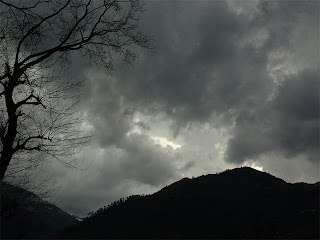There seem to be many a scientific proponent of the premise that the increasingly erratic monsoons in the subcontinent have a correlation with Black Carbon (soot) from incomplete combustion of fossil fuels. Oceanographer, writer, Danielle Meitiv captures the scientific work done so far in her blog.
Says Danielle, pollutants, particularly black carbon (BC), are affecting the monsoons by a process that starts in the winter when soot combines with dust blown from the west, creating huge clouds of haze that hug the southern slopes of the Himalayas.
Danielle explains, "The BC in these clouds absorb solar radiation, warming the air even faster than usual. This draws more moisture to the region sooner, causing the early monsoon to intensify. This theory is known as the Elevated Heat Pump, as the soot acts to pump heat up the Himalayan slopes. Observations show a widespread and sustained warming in the pre-monsoon season over the last three decades. In that same time period, early monsoon rainfall has increased by 20% ."
"Over the oceans, BC has a different, although equally damaging effect. BC combines with other anthropogenic aerosols, forming Atmospheric Brown Clouds (ABCs), large plumes of particles that can stretch over whole continents or ocean basins. These ABCs absorb solar radiation in the atmosphere, causing dimming below. This reduction of irradiance reduces evaporation and cools the surface, leading to a weakening of the later monsoon."
"The combined impact of these two phenomena, the Elevated Heat Pump and Solar Dimming, increases flooding during the early months of monsoon, and causes drought later on. Some studies suggest that over time the result will be an overall weakening of the monsoon and a reduction of rainfall over the region. Reduction in rainfall of great concern because in South Asia there is a strong positive correlation between the amount of precipitation and food production. The Indian summer monsoon is the biggest source of freshwater to the region: over 70% of the annual precipitation over India occurs during the summer monsoon."
skip to main |
skip to sidebar
THE READING LIST
- World Lung Foundation: Acute Respiratory Infections Atlas
- Searching for Fundi and studying the three-stone stove in Kalinzi
- Karibu Tena: Rocket Stoves in Mwamgongo
- Black Carbon Emissions in Asia
- Capacity Development for Scaling Up Decentralized Energy Access Programmes: Lessons from Nepal on its role, costs, and financing
- The Indian National Initiative for Advanced Biomass Cookstoves: The benefits of clean combustion
- The Hartwell Paper: A new direction for climate policy after the crash of 2009
- PERU HEALTHY KITCHEN/HEALTHY STOVE PILOT PROJECT
- US Climate Bill: Kerry Lieberman' American Power Act
Followers
Blog Archive
-
▼
2010
(93)
-
▼
April
(10)
- Secretary Clinton says Cookstoves among the Big Id...
- Enhance Efficiency of Use of Agro Residue
- Grameen Shakti plans to Construct Million Cookstov...
- Shell Foundation Partners MFIs to Tackle the Affo...
- UC Berkeley Sensors Takes Top Prize in Vodafone In...
- Indian Government prepares Action Plan for Improve...
- COPD and Indoor Air Pollution
- Shimoga's Village Health Workers Campaign on Indoo...
- Cookstoves: The Secret Weapon Against Poverty and ...
- Is Kitchen Smoke Killing the Monsoons?
-
▼
April
(10)
IMPROVED COOK STOVES
VIDEO RECORD
Enterprise Based Solutions for Improved Cook Stoves
Routes to Market for Improved Cook Stoves
Shell Foundation Press Conference on Indoor Air Pollution
Interview Jeroen Blum, Deputy Director, Shell Foundation
Clearing the Air on Indoor Air in Koppal
Khidki Amma Noses Around
Envirofit Cookstove Ambassador Minniamma
South India Pilot Campaign
Shell Foundation Campaign in Shimoga
Secretary Clinton Announces the Global Alliance for Clean Cookstoves
The Burden of Firewood
The Silent Killer In The Kitchen
The Stove Solution
The Stove Solution
The Aprovecho Institutional Rocket Stove
Step by step guide to build a RIPPLE Rocket fuel efficient cookstove
Malawi – The RIPPLE Rocket fuel efficient cookstove


